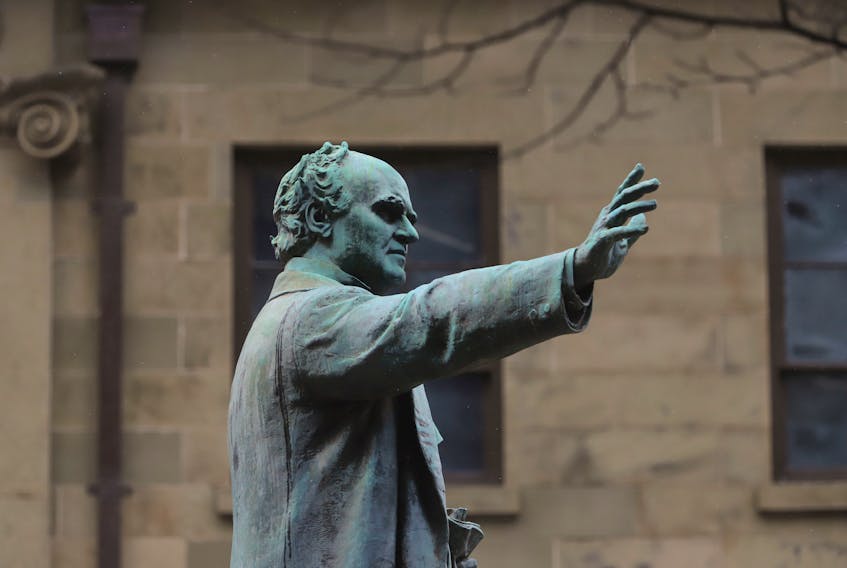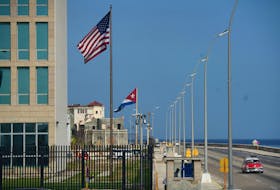It was quiet on Tuesday in Nova Scotia’s legislative library, like the rest of Nova Scotia’s House of Assembly, which is closed to the public due to the pandemic.
So, no cruise ship visitors from Des Moines, or school kids from Spryfield, milled around the room, staring back at the big oil paintings of Malachi Salter, one of the first members of the assembly, and Edward Duke of Kent, running a finger along the wrought-iron alcoves, perhaps even pulling a volume from the shelves for a quick look.
“When you first walk in here, you do feel like you are going back into time,” legislative librarian David McDonald told me.
Back, perhaps, to when premier George Murray, our longest serving premier, or John Thompson, the future prime minister, wandered into that room looking for something.
Or possibly to an even earlier time when a staffer for Sir Charles Tupper might have rooted around for a document in there to bolster his argument for bringing Nova Scotia into Confederation.
Before, that, when the Supreme Court of Nova Scotia convened in that space — which is the time with which we are concerned today — the ceiling was about double the height it is now.
Back then, when the judge emerged from his chambers and proceeded to his dais — about where the library’s reference desk now stands — a jury would have sat off to one side.
The witness docket, according to a long-ago floor plan which McDonald sent me, would have been in front of the judge.
The spectators would have squeezed onto a raised platform, offering a good view of the proceedings.
When Joseph Howe, a newspaper editor fighting for his publication’s survival, stood in the Supreme Court on March 2, 1835, the room was hot and overflowing.
If he looked through the chamber window he might have had a view of the hawkers selling their wares at the Cheapside market, and, beyond, glimpsed a schooner’s mast down in the harbour, although I imagine he had too much on his mind for anything like that.
By now you may have guessed why I’m writing this.
The trial that played out there 186 years ago on Tuesday was the most famous ever held in this province even if, as McDonald points out, the view that those events “actually brought about freedom of the press (in Canada) is a complete and utter fallacy.”
But the spectacle, the David vs. Goliath narrative, the high human drama, still has the power to rivet.
On the one side, a crusading editor whose paper had accused the cabal of politicians, high colonial officials and businessmen who controlled the province of running Nova Scotia’s affairs in a “slovenly, extravagant and unpopular manner,” of lavishing the hard earnings of its people on an elite “who repay their ill-timed generosity with contempt and insult, of pilfering money meant for the province’s poor."
On the other, the pashas of Halifax, who charged Howe with seditious libel in the hope of ruining him professionally and financially.
Such a strategy was often employed in those days by the country’s monied elite who threatened to sue anyone with the temerity of criticizing them.
This time, in his paper the NovaScotian, Howe warned that, win or lose, his accusers would not “bear their banners unsullied from the field.”
No lawyer would take his case. So, Howe borrowed a law text, studied up and pleaded his own defence.
My research shows that he only had time to memorize the first two paragraphs of his case. I would encourage you to read his entire argument, found on the provincial government’s website, which took six-and-a-quarter hours for Howe to make, but is worth your time and effort.
I imagine Howe as the statue on the grounds of the legislature shows him: long of torso and thick of side-burn, right arm extended as if he was caught in mid-sentence masterfully laying out yet another example of how the notables of Halifax lined their own pockets at the expense of the city’s unfortunates.
It’s said that the jury only took 10 minutes to acquit Howe, a story that perhaps sounds a little too ready-made-for-myth.
McDonald also isn’t sure about another oft-repeated fact: that, when the verdict came in, the people in the gallery hoisted Howe onto their shoulders and carried the publisher victoriously through Halifax’s downtown streets.
History does tell us that, even if the battle for the freedom of the press was far from over in this country, Howe’s acquittal was a landmark decision, and also signalled the beginning of the end for the cronyism and corruption that characterized the way things were run around here.
By 1860, the Supreme Court had relocated to Spring Garden Road. Two years later, the legislative library opened in its current location, where, when there is no pandemic, visitors like to come and see where one March day a man found words that, after all this time, still matter.









